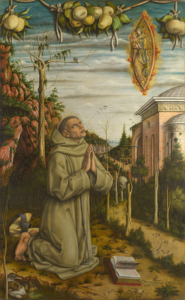by Anita Di Rienzo, Milan.

Ancient paintings are often referred to as ‘pieces of history’, a definition which explains how a work of art acquires greater meaning, showing how we are able to historicise and exchange information through paintings. What is a painting in the end if not the only language common to all, through which it is possible to communicate with generations that have long since disappeared?
Paintings are visual documents which hand down through the centuries both events and their protagonists. However, this recognition can only partly reveal what lies behind the beauty of a masterpiece, and a greater familiarity with the time and place in which a work of art performed its function is important in order to grasp what could be defined as the ‘subliminal message’.
The term is borrowed from the language of advertising, referring to information that the brain unconsciously assimilates. On a practical level, it has been an expedient used for centuries by painters and their clients to convey a meaning which could not otherwise be expressed. The Vision of the Blessed Gabriele Ferretti, a painting by Carlo Crivelli, is a particularly appropriate example. The painting, now at the National Gallery of London, was originally in the church of the Franciscan monastery in Ancona, where the viewer, entering the semi-darkness of the church, was attracted by an apparently familiar figure – a Franciscan friar kneeling in prayer and captivated by a divine vision. This composition would have recalled the widespread iconography of the stigmatization of St Francis. The initial confusion in the identification of the subject was due to the need to catch the attention of the faithful and then, afterwards, to provide a contemporary and virtuous example of a local religious man while publicising the most influential surname in Ancona during the 15th century: Ferretti. Those who saw the painting were not necessarily aware of this ploy by the Ferretti family, but the name would have remained imprinted on their unconscious, just like the subliminal messages in today’s commercials.
But why use Blessed Gabriel? Couldn’t the Ferretti family assert the importance of their name without an intermediary? At the time Ancona was a maritime republic, based on an oligarchic system. Explicit celebration of a single family was not approved. Eye-catching iconography and a pious family member were the only gimmicks acceptable to the society of the time.
So perhaps there is nothing new under the sun when it comes to neuro-marketing and the involvement of the unconscious in marketing strategies, as Carlo Crivelli’s painting teaches us, art, in all its forms, has always been and always will be a medium for the transmission of timeless teachings.
Visit the National Gallery of London when it reopens and linger in front of Carlo Crivelli’s masterpiece because, in my opinion, no message has ever been conveyed with such grace.
volume 34 no 5 May / June 2020
